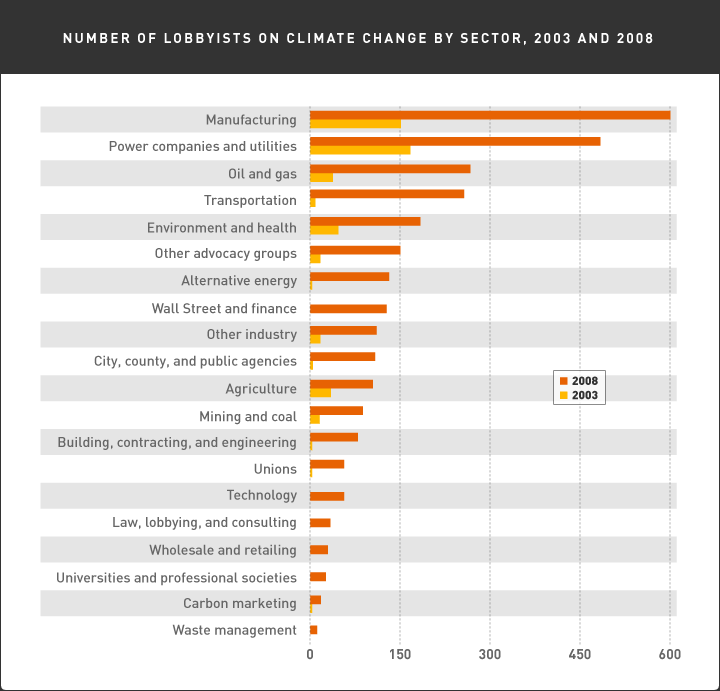
After years of resistance from the Bush administration, global warming advocates are convinced the time has come for passage of major climate change legislation.
But even with a sympathetic White House and Congress, the years of delay might well have complicated their task as an army of lobbyists assembled to do battle over the issue.
A Center for Public Integrity analysis of Senate lobbying disclosure forms shows that more than 770 companies and interest groups hired an estimated 2,340 lobbyists to influence federal policy on climate change in the past year, as the issue gathered momentum and a bill came to a vote in Congress.
That's an increase of more than 300 percent in the number of global warming lobbyists since 2003, when Congress previously voted on climate change legislation, and means that Washington can now boast more than four climate lobbyists for every member of Congress.
It also means that 15 percent of all Washington lobbyists spent at least some of their time on global warming last year, based on a tally of the total number of influence peddlers on Capitol Hill by the Center for Responsive Politics.
The center estimates that lobbying expenditures on climate change last year topped $90 million. About 130 businesses and interest groups spent more than $23.5 million on lobbying teams solely focused on climate, but that vastly understates the money devoted to the effort.
More than 95 percent of climate lobbyists work on other issues for their clients as well, and they don't have to report how much they're being paid on global warming specifically. But even if just 10 percent of their time last year was spent on climate issues, that would add nearly $70 million to the grand total spent lobbying on climate in 2008.
Good news, bad news
Many environmental advocates have treated the proliferation of voices as a positive.
When giants such as General Electric, Johnson & Johnson, Alcoa and DuPont are on record favoring so-called cap-and-trade legislation, "it moves the politics on this issue to a new place," said Eileen Claussen, president of the Pew Center on Global Climate Change.
Chelsea Maxwell, a former Senate staffer who worked on last year's legislation, says the lobbying boom is a sign that climate has claimed its place as a major issue on Capitol Hill.
"Five years ago, people saw climate change as an environmental issue, and it really goes beyond that," Maxwell said. "It's an energy issue. It's a national security issue. It's a tax issue. It's an immigration issue. It has so many facets that, as those constituencies start seeing there's likelihood of movement on the Hill, then, of course, people want to make sure their interests are ... represented."
Maxwell, who now works for the Washington consulting firm The Clark Group, is optimistic about the prospects for climate legislation - even amid the lobbying blitz. "I don't think it's impossible," she said. "What it's going to take is a lot of deliberation."
But the lobbying onslaught has alarmed others, who fear compromises among the myriad interests will dilute the sort of aggressive action that's needed.
In one of several open letters penned in recent weeks to President Barack Obama, NASA's James Hansen, a climate scientist, warned: "The danger is that special interests will dilute and torque government policies, causing the climate to pass tipping points, with grave consequences for all life on the planet."
Players
The ranks of the climate lobbyists include a who's who of ex-members of Congress, from former House Majority Leader Richard Gephardt (D-Mo.) to former House Appropriations Committee Chairman Robert Livingston (R-La.).
Among the former Capitol Hill staffers who are engaged are Drew Maloney, former top aide to then-House Majority Whip Tom Delay (R-Texas), and Andrew Athy, a former counsel to Rep. John Dingell (D-Mich.), who later chaired the House Energy and Commerce Committee.
Executive branch veterans include Jack Quinn, White House counsel to President Bill Clinton, and Wayne Berman, assistant commerce secretary under President George H.W. Bush.
The roster of interests seeking to influence the legislation is growing and changing, as well.
In 2003, the first time the Senate voted on a climate policy proposal, the 150-or-so groups lobbying on the issue represented a narrow range of interests, led by power companies. Seventy percent, in fact, were electricity, coal and oil firms and the heavy industries like auto, cement and steel that would be most directly affected by curbing fossil fuel use.
Opposing them were nine environmental groups.
By 2008, when the Senate again considered a broad program to curb the carbon dioxide emissions, virtually every segment of the economy was seeking to weigh in on the legislation.
One major new player is the American Coalition for Clean Coal Electricity - a lobbying organization unveiled just last spring. Representing 48 mining firms, coal-hauling railroads and coal-burning power companies, ACCCE spent $9.95 million lobbying Congress on climate in 2008 - more than any other organization solely dedicated to the issue.
ACCCE's position illustrates the complex positioning that is taking place on the legislation.
The mining companies say they support a mandatory federal program to curb the emissions produced by its own members - as long the policy would keep electricity affordable, domestically produced and reliable. And that means encouraging, in ACCCE's words, "robust utilization of coal."
That's a tall order, since there's no technology on the shelf today that scrubs the carbon out of coal-fired power. So what ACCCE is asking for is money to develop that technology.
Others, including the numerous alternative energy companies, are also looking for research grants and other government help. In 2003, there were fewer than five alternative energy industry lobbyists registered specifically on climate. By 2008, there were more than 130.
Then there are the Wall Street banks such as Goldman Sachs and JPMorgan Chase, as well as private equity firms, which want a stake in a new carbon market created under the proposed cap-and-trade system favored by most pro-climate action politicians. The finance industry had roughly as many climate lobbyists as alternative energy - about 130 representatives.
Local government is also seeking a piece of the pie: the revenue that a climate program would generate when power plants, oil companies and others have to buy "permits" from the federal government to continue emitting carbon dioxide. Cities, counties and municipal agencies have more than 100 lobbyists either following climate developments on Capitol Hill or seeking to shape the formulas lawmakers will use for doling out money.
Finally, last year also saw dramatic growth among environmental and health lobbyists, who numbered fewer than 50 five years ago and grew to about 185 last year. The old green groups such as the Sierra Club and the National Wildlife Federation have now been joined by a new wave of interests, from the American Academy of Pediatrics to the Evangelical Environmental Network.
Reading the tea leaves
Even without so many competing agendas, the political hurdles to pass climate legislation - in whatever form - are formidable.
Last year's Senate bill, sponsored by Sens. John Warner (R-Va.) and Joseph I. Lieberman (I-Conn.), got the support of 48 senators. Climate action advocates picked up three new allies in November: Democratic Sens. Mark Begich of Alaska, Mark Udall of Colorado and Tom Udall of New Mexico. But that still leaves advocates well short of a filibuster-resistant 60 votes.
Environmental Defense Fund lobbyist Mark MacLeod notes how little the landscape has changed.
"We still have to do something to address the issues about coal. We still have to do something about to address the issues about Detroit," MacLeod said. "All those issues did not go away because of who the president is and because there's a handful more members who support doing something."
Energy lobbyists on all sides are trying to read the tea leaves to predict how aggressively the new president plans to push on the issue.
Obama has called for returning greenhouse gas emissions to 1990 levels by 2020 and for an 80 percent reduction by 2050. Critics say those goals are too modest, but they surpass anything Congress has previously attempted.
Still, the president has populated his administration with climate advocates and go-slow-on-climate advisers. And energy lobbyists say there's little public support for climate action, given the economic crisis.
In a January poll from the Pew Center for People and the Press, global warming ranked dead last in a list of 20 priorities.




NOW LSD IS BACK IN THE NEWS